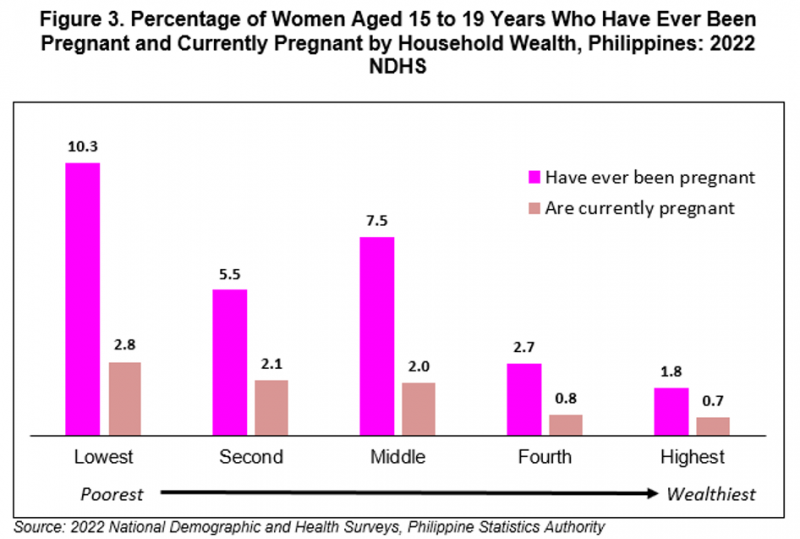🐰 TL;DR
Teenage pregnancy in the Philippines remains a major health and social concern. While cases among older teens have declined, pregnancies among adolescents are rising, bringing health, social, and economic consequences.
- Poverty, limited sex education, and cultural taboos drive risks
- Young mothers face serious health complications and stigma
- Education and job prospects often decline after early pregnancy
- Prevention calls for schools, families, communities, and policy action
Teenage pregnancy is still one of the biggest public health and social challenges in the Philippines. While there has been some progress, the country continues to rank among those with the highest adolescent birth rates in Southeast Asia.
Data from the Philippine Statistics Authority shows that the share of girls aged 15–19 who had ever been pregnant went down from 8.6% in 2017 to 5.4% in 2022. But the drop tells only part of the story. Among younger adolescents, the numbers are moving in the opposite direction. Live births among girls aged 10–14 rose by more than 6% from 2019 to 2023, with over 3,300 cases recorded in the most recent year.
The effects ripple far beyond the mother and child. Teenage mothers face higher health risks, interrupted schooling, and limited job opportunities later in life. Families and communities also carry the strain, reinforcing cycles of poverty and inequality.
This article looks at the causes, the real-life impact, and the steps that can help address teenage pregnancy in the Philippines.
Causes of Teenage Pregnancy in the Philippines
Teenage pregnancy does not happen in isolation. It reflects gaps in education, family communication, access to health services, and broader social and cultural pressures. In the Philippines, these factors often overlap, creating conditions where adolescents face higher risks of unplanned pregnancies.
1. Gaps in sexuality education
Although comprehensive sexuality education (CSE) has been part of the K–12 curriculum since 2018, implementation is uneven. In many schools, especially in rural areas and faith-based institutions, lessons are limited or avoided altogether.
This leaves teens without reliable knowledge about their bodies, consent, or contraception. Many turn to social media or pornography for answers, only to encounter misinformation that fuels unhealthy behaviors and myths.
2. Poverty and economic hardship
Economic background plays a strong role. Girls from low-income households have fewer opportunities to finish school and often lack access to health services. In 2022, around 10% of women aged 15–19 in the poorest households had been pregnant, compared to less than 2% in the wealthiest group.

Limited financial security can also push families or partners to see early pregnancy or marriage as a form of stability, even if it restricts young women’s futures.
3. Cultural and religious influences
Strong cultural and religious beliefs shape attitudes about sex and contraception. In many communities, open conversations about reproductive health are discouraged. Talking about contraception may be seen as taboo, while abstinence is treated as the only acceptable option. This silence prevents teenagers from seeking help or making informed choices.
4. Barriers to contraceptives and health services
Even when young people want protection, they face hurdles. In the Philippines, minors under 18 need parental consent to access contraceptives, a requirement that discourages many from seeking help. Clinics and pharmacies are often not designed to provide youth-friendly services. Confidentiality may not be guaranteed, and judgment from providers can drive teens away.
5. Sexual violence and power imbalances
Another disturbing factor is coercion and abuse. Many adolescent pregnancies involve older men. Data shows that only a small percentage of births among 15–19-year-olds are fathered by males in the same age group. This points to unequal power dynamics and highlights the risks of sexual violence, grooming, and exploitation.
6. Lack of communication at home
Parents and guardians also struggle to guide teens through these issues. Socio-cultural taboos and their own discomfort often prevent open conversations about sexuality and reproductive health. Without clear guidance, many teenagers are left to navigate risky situations on their own.
Taken together, these causes create a cycle that reinforces itself: limited education leads to poor decisions, poverty reduces options, cultural silence blocks dialogue, and lack of support leaves teens vulnerable. Breaking that cycle requires interventions across families, schools, health systems, and communities.
The Real-Life Consequences for Teens and Society
Teenage pregnancy creates challenges that touch nearly every aspect of life. The table below summarizes the major areas of impact and their effects on both young mothers and the broader community.
| Area of Impact | Consequences |
| Health risks | Higher chances of eclampsia, infections, and anemia for mothers; babies face premature birth, low birth weight, and higher infant mortality. |
| Education | Nearly 60% of girls who drop out cite pregnancy or marriage. Fewer than one in three teen mothers complete high school. |
| Economic costs | Reduced earning potential for young mothers; estimated ₱33 billion lost annually in foregone earnings and productivity. |
| Emotional & social effects | Stigma, pressure into early marriage, depression, anxiety, and social isolation. |
| Intergenerational impact | Children of teen mothers face higher risks of behavioral problems, school difficulties, and repeating the cycle of early pregnancy. |
Health risks for mothers and babies
Adolescents face higher medical risks compared to women in their twenties. Complications such as eclampsia, infections, and severe anemia are more common in younger mothers. Girls under 15 are especially vulnerable. They’re about twice as likely to die from pregnancy-related causes.
Meanwhile, babies born to adolescent mothers have a higher chance of being premature, underweight, or suffering from long-term health complications. Some face an increased risk of dying in the first year of life. These challenges can affect a child’s growth, learning ability, and overall quality of life.
Educational setbacks
Early motherhood often interrupts schooling. In the Philippines, nearly 60% of girls who leave school early cite pregnancy or marriage as the reason. Less than one in three teenage mothers finish high school. This disruption limits academic achievement and narrows future job opportunities.
Economic disadvantages
The personal impact quickly translates into economic costs. Young mothers who cannot complete their education face reduced earning potential. Over time, this adds up to lost income for households and lost productivity for the wider economy. Estimates suggest that teenage pregnancy costs the Philippines as much as ₱33 billion each year in foregone earnings and opportunities.
Emotional and social challenges
Teenage mothers often carry the burden of stigma. Some are pressured into early marriages to “protect family honor,” while others face judgment in their schools and communities. The result is higher rates of depression, anxiety, and isolation. Without support, these struggles can last well into adulthood.
Intergenerational effects
Children of teen mothers are more likely to experience difficulties in school, behavioral problems, and limited economic mobility. Sons are statistically more likely to come into conflict with the law, while daughters face a greater chance of becoming young mothers themselves. The cycle of disadvantage continues, spreading the impact from one generation to the next.
Helping Prevent Teenage Pregnancy: From Personal Choices to Collective Action
Preventing early pregnancies in the Philippines requires more than one solution. It involves families, schools, communities, and policymakers working together while also empowering young people to make informed choices. Here are key strategies that can help reduce teenage pregnancy in the country.
1. Strengthen sexuality education
Comprehensive sexuality education (CSE) equips young people with accurate, age-appropriate knowledge about reproductive health, consent, and relationships.
While abstinence is the only guaranteed way to avoid pregnancy, CSE also covers contraceptives and safe practices for those who are sexually active. Consistent implementation in schools, supported by teachers and parents, helps close the gaps left by social taboos and misinformation.

2. Improve access to youth-friendly health services
Adolescents often hesitate to visit clinics because of stigma or lack of confidentiality. Establishing adolescent-friendly facilities, where privacy and non-judgmental care are assured, encourages teens to seek help. Making contraceptives affordable and accessible without unnecessary legal barriers is also crucial for those who need them.
3. Support open communication at home
Parents and caregivers play a central role in guiding adolescents. When adults are equipped to talk openly about sexuality and reproductive health, teens are less likely to rely on unreliable sources. Programs like Save the Children’s “HEART to Heart” have shown how training parents can foster healthier conversations and reduce risks.
4. Engage communities and leaders
Local leaders, religious groups, and community organizations can influence attitudes toward early pregnancy and contraception. Mobilizing them to promote gender equality, delay marriage, and encourage responsible choices can create a more supportive environment for teens.
5. Expand education and economic opportunities
Keeping girls in school is one of the most effective ways to reduce adolescent pregnancies. Scholarships, conditional cash transfers, and re-entry programs for young mothers help them stay on track. Providing access to financial literacy and skills training also broadens opportunities beyond early marriage or motherhood.
6. Address sexual violence and power dynamics
Many adolescent pregnancies stem from coercion or abuse by older partners. Stronger enforcement of laws against child marriage and statutory rape, paired with safe reporting mechanisms, helps protect vulnerable girls. Community awareness campaigns can also challenge harmful gender norms and empower boys to be allies in prevention.
7. Push for effective policies and legislation
Policy reform remains critical. While the Adolescent Pregnancy Prevention Bill has faced setbacks, it highlights the need for a national framework to protect adolescents and provide consistent support. Even without new laws, full enforcement of the Responsible Parenthood and Reproductive Health Act can improve access to information and services.
8. Involve adolescents in decision-making
Young people themselves should have a voice in programs that affect their health and futures. Initiatives that include adolescents in planning and evaluation ensure that interventions remain relevant, practical, and respectful of their realities.
Responsible Choices Start Here
Teenage pregnancy continues to shape the lives of thousands of young Filipinos each year. While the numbers reveal both progress and setbacks, the solutions are clear: stronger education, accessible health services, and supportive communities all play a role in breaking the cycle. Real change happens when collective responsibility meets personal empowerment.
At the same time, building a culture of safe, informed choices matters. If you’re looking for a trusted adult shop that values privacy and accessibility, Pink Bunny is here for you. We offer discreet packaging for peace of mind, convenient same-day service within NCR or cash on delivery options, and free delivery for purchases over ₱1,490.
You can also visit our branches in Makati, Angeles, and Cebu, or shop online anytime. You’ll find a team ready to provide a comfortable, respectful experience from browsing to checkout.
Got questions or ready to explore more? Reach out to Pink Bunny directly on WhatsApp or Viber at 0928 382 8623.
FAQs on Teenage Pregnancy in the Philippines
Teenage pregnancy in the Philippines is driven by limited sexuality education, poverty, cultural taboos, and barriers to contraceptives. These factors often overlap and leave adolescents with fewer safe choices.
Lack of communication at home and sexual violence also raise risks.
It creates serious health risks for young mothers and their babies, disrupts education, and limits economic opportunities. Families and communities bear long-term costs, reinforcing cycles of poverty and inequality.
Prevention requires comprehensive sex education, youth-friendly health services, family support, and community engagement. Expanding education and economic opportunities for girls also reduces risks.
See the WHO guideline on prevention for global strategies.
Teen mothers often leave school early. Nearly 60% of girls who drop out cite pregnancy or marriage, and fewer than one in three finish high school—limiting career opportunities later in life.
The Philippines enforces the Responsible Parenthood and Reproductive Health Act, which covers sex education and contraception. However, the proposed Adolescent Pregnancy Prevention Bill remains stalled in Congress due to political and cultural opposition.




